Warning: Picture and text heavy!
Reviewer's Note: The NiteCore D20 was provided for review by Edgetac (NiteCore).
The NiteCore D20 is the latest offering in the piston-drive "SmartPD" family from Edgetac (NiteCore). Although a lot of the basic design and circuit functioning is similar to the 1AA D10, this new 2AA model features some significant build differences.
The main distinguishing features of all the NiteCore Smart PD lights is their simple continuously-variable interface, and innovative McGizmo "piston drive" design that doesn't use a clicky switch. For a comparison to the 1AA D10, please see my earlier reviews:
NiteCore D10 & EX10 Reviews: RUNTIMES, BEAMSHOTS, COMPARISONS & more!
NiteCore Golden Dragon Plus D10 & EX10 Reviews: BEAMSHOTS, RUNTIMES, etc.

The light comes in a sturdy hard cardboard box with magnetic closing flap. The pocket clip was already attached. Along with the light and clip come a manual, warranty card, good quality wrist strap, extra o-rings, extra clip screws, and a mini-Allen key for the clip screws.
Approximate retail price: $70 USD
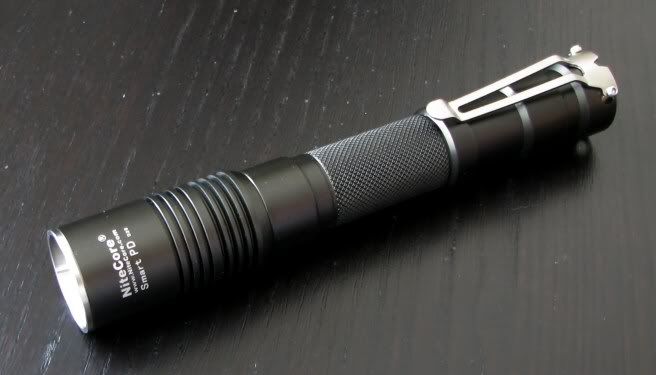
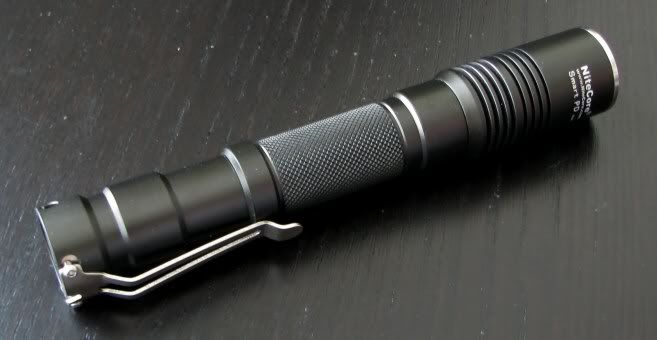
Here is how it compares to the competition:
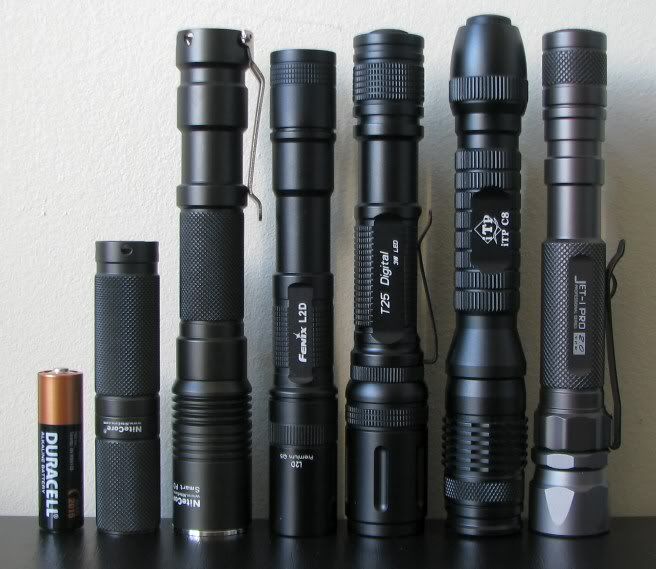
From left to right: Duracell 1AA alkaline, NiteCore D10, NiteCore D20, Fenix L2D, Olight T25, ITP C8 Tactical, JetBeam Jet-I PRO EX V2.
D20 Weight: 109.3g
D20 Dimensions: Length: 154.0mm x Width: 25.0mm (head), 23.2mm tail (without clip)
The obvious build difference on this 2AA version is the heft – the light is surprisingly bulkier than the 1AA model. oo: Although well balanced and comfortable in the hand, this light is definitely one of the most substantial in the 2AA class. The bezel is wider than the 1AA model, and the head unit has heatsinking fins at its base.
oo: Although well balanced and comfortable in the hand, this light is definitely one of the most substantial in the 2AA class. The bezel is wider than the 1AA model, and the head unit has heatsinking fins at its base.
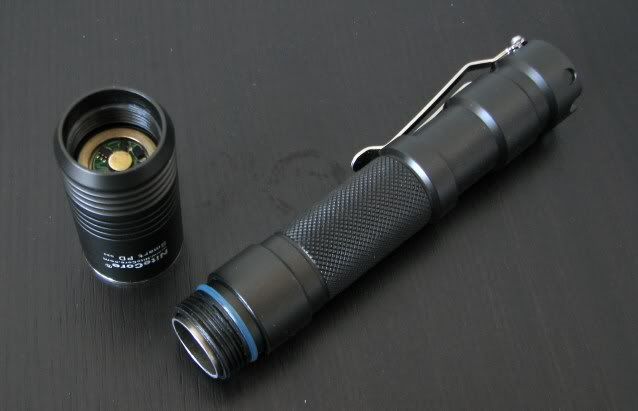
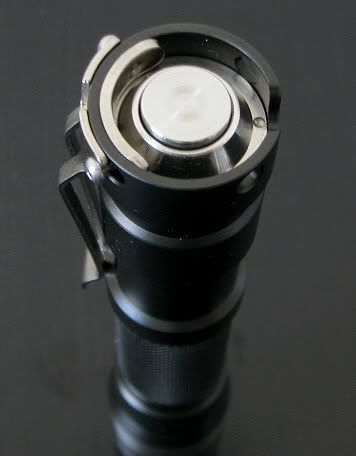
One of the most obvious changes is the introduction of the clip at the tailcap, with its stainless steel clip holder and retaining ring. Edgetac includes a mini Allen key, but a 3/32nd hex screwdriver will also fit. The tailcap retaining ring should reinforce the aluminium in this area, and increase long-term durability. :twothumbs
Unlike the 1AA version, the piston cannot be removed from the open end of the body tube (i.e. near the head) – if you want to access the piston, you need to remove the clip and unscrew the piston opening retaining ring (you'll need a pair of tweezers or snap-ring pliers). Not that there is any real reason to do so, unless you want to check the lube status of the piston o-ring.
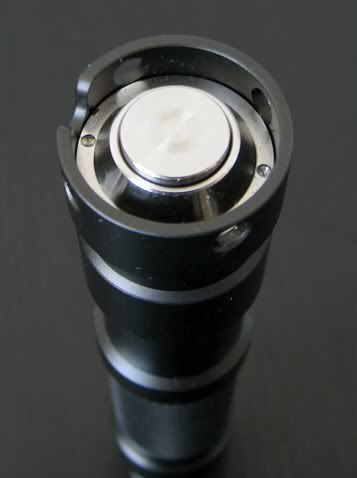
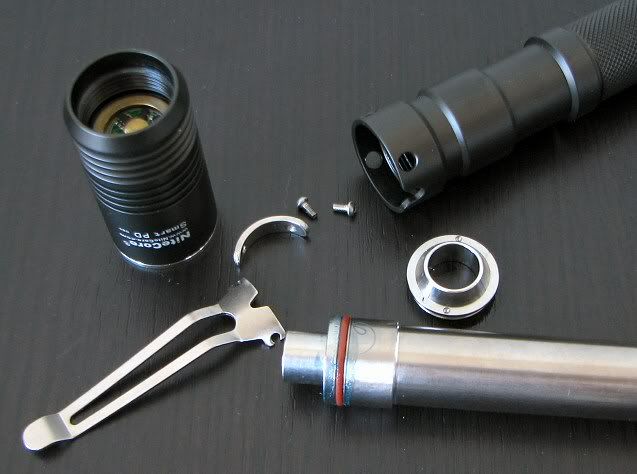
As you can see in my disassembled pics above, NiteCore is still using a lot of the high-viscosity blue-colour lube on the o-rings. :shrug: Although not causing a problem on this sample, a number of the D10/EX10 lights have issues with "sticking" pistons with this lube. The problem is easily solved after disassembly by a quick wipe off of excess lube, or addition of lower viscosity lube, like PTFE (i.e. Teflon, like from the Radio Shack Precision Oiler)
UPDATE: I find the PTFE lube wears off after a couple of weeks, leading to a "clinking" sound when the bare metal piston meets the aluminum body. I am now trying a little of the more viscous Nyogel 760G, which seems to be working well. Wouldn't normally be a problem to just re-lube periodically, but having to disassemble the clip and retaining ring on the D20 each time means you need to have tools with you.
The purpose of this re-design quickly becomes apparent – the light has a fully functioning tailcap lock-out feature now. :thumbsup: Previously, you could partially lock-out the light by significantly unscrewing the head – making it harder for the piston to engage. But this was not a true lock-out – the piston drive could always be engaged with enough force. Now, the piston can only travel so far up the battery tube, so once you unscrew the head pass a certain point, the light cannot be engaged. Well done.
Fit and finish is excellent on my samples - lettering is very clear and sharp, and anodizing is flawless. Note the knurling on all the NiteCore Smart PD light is more aggressive than pretty much any other Chinese light maker I've seen. Still not quite as severe as Surefire lights, though.
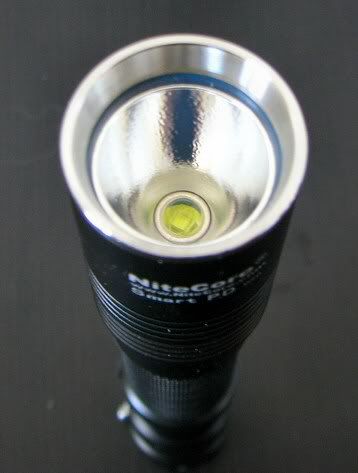
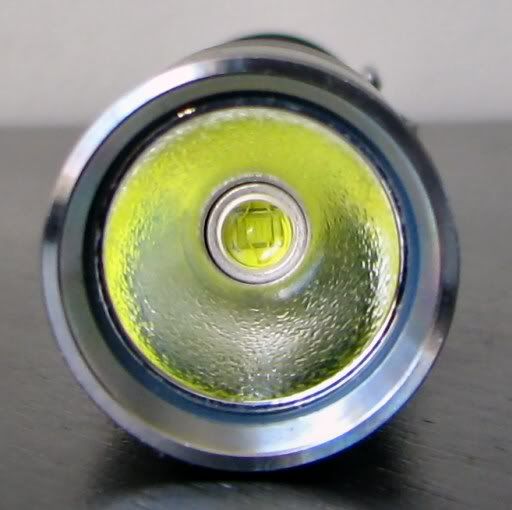
The head/reflector has been redesigned from the D10/EX10/NDI, with a wider and deeper reflector with a new stainless steel bezel ring. Despite this deeper reflector, throw is not increased as much as you might expect (scroll down for a throw/output comparison). My sample came with a Cree Q5 emitter, as you can see.
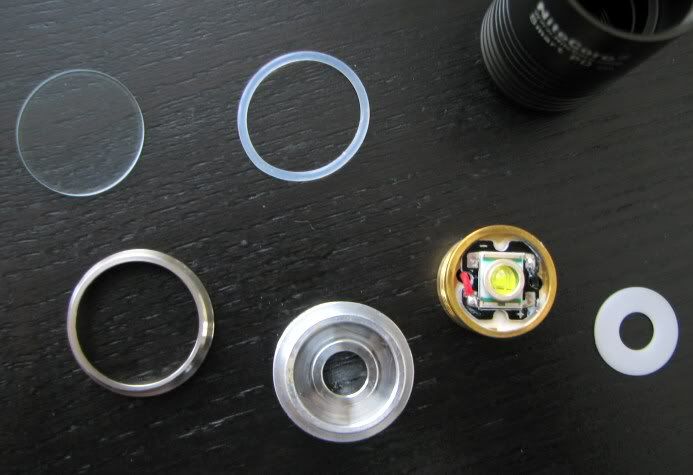
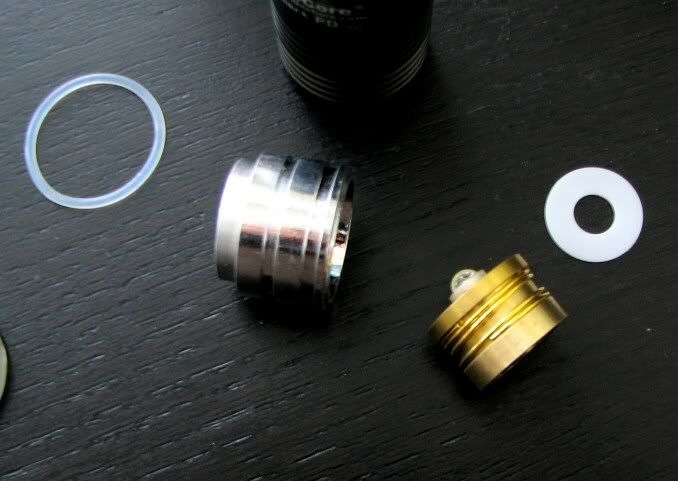
I've opened the head up to show you the insides - it comes apart fairly easily by unscrewing the bezel retaining ring (i.e. pressing on it firmly with a soft cloth). You can see the spring on the light engine. It all fits together well, so there's no real adjustment you can make. The reflector has a nice groove/lip to help hold the o-ring, so re-assembly is a snap.
Piston Drive & User Interface
Please see my NiteCore D10/EX10 review for a detailed discussion of how the basic Piston Drive mechanism and UI works.
Simply put, the batteries sit inside the piston tube, and switching occurs entirely in the head (i.e. the current path is through the piston sleeve and not the body). The contact ring in the head is spring-mounted, and in combination with the MCU can produce different modes and features depending of degree of force applied to the piston. This innovative design also allows you to utilize the light in a couple of different ways (i.e. as both a "twisty" and "clicky" light).
The UI is actually quite straightforward and easy to use. For a good instruction on how to use it, see 4sevens' D10 video guide here:
http://www.youtube.com/watch?v=irqhuV8Xo_A
So what's new with the circuit? One welcome change is that auto ramping in the reverse direction after using the shortcuts to Min or Max now works. :twothumbs On the 1st generation SmartPD lights, you needed to press and release and press again to get it to start ramping in the reverse direction after using a shortcut (double-click for Min, click-hold for Max).
Another change has been to increase the number of discrete output states from 100 to 256, according to NiteCore. As a result, I would have expected a longer ramping time, but NiteCore has kept the total ramp length down to about 6-7secs, which is just a second longer than the D10/EX10.
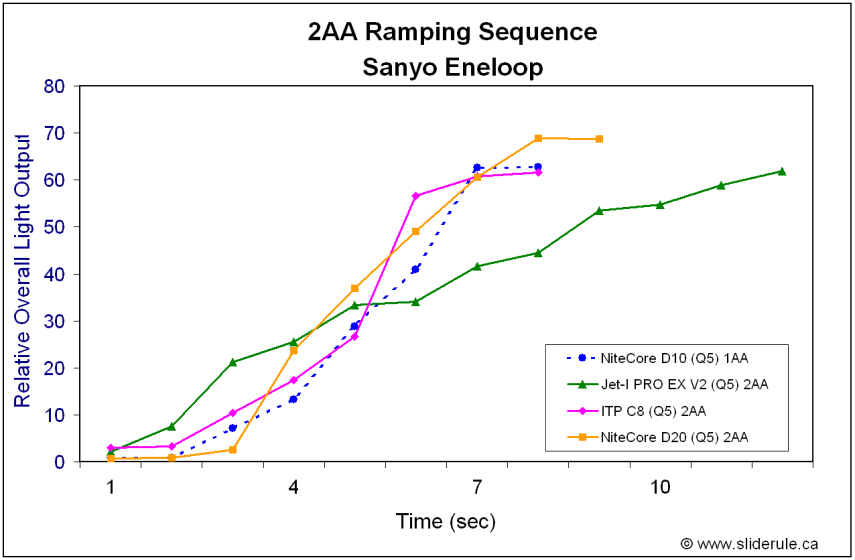
If anything, ramping is even more visually-linear now than it was before. But I find I rather miss the slower initial ramp at the lowest outputs (i.e. the D10 spends more time there, proportionally-speaking).
Comparison Beamshots
Both lights are on 100% on Sanyo Eneloop (~2100mAh), about 0.5 meters from a white wall.
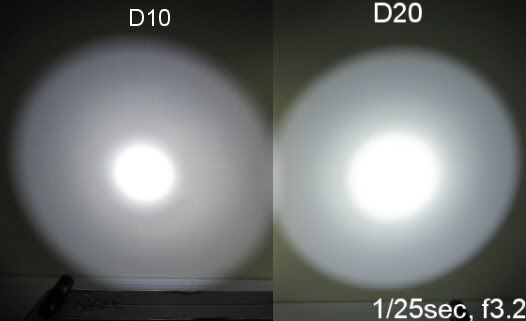
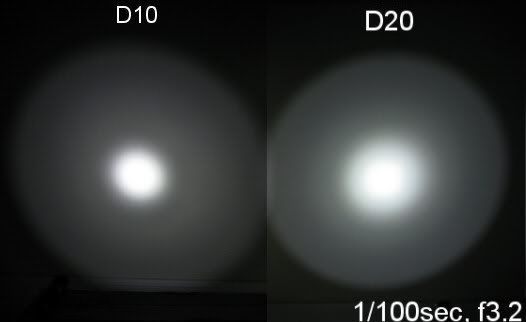
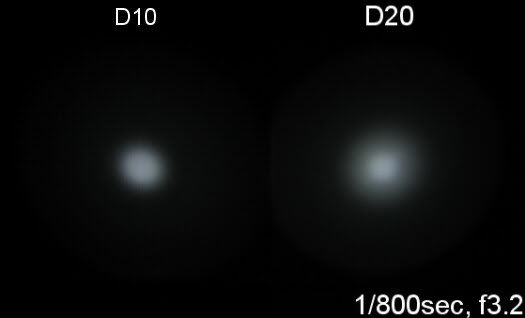
As you can see, the beam profile is quite different. Gone on the D20 is the typical dark Cree ring around the hotspot – instead, you can see the D20 hotspot is a lot broader and more diffuse. This relative "defocusing" of the hotspot gives you less throw than you might expect for a bigger reflector. Overall spillbeam width is slightly narrower as well now.
For detailed comparison to its class of 2AA lights, I've rounded up the usual suspects:

From left to right: Duracell 1AA alkaline, NiteCore D10, NiteCore D20, Fenix L2D, Olight T25, ITP C8 Tactical, JetBeam Jet-I PRO EX V2. Not shown is the new Fenix LD20.
All lights are on 100% on 2X Sanyo Eneloop (~2100mAh), about 0.5 meters from a white wall.
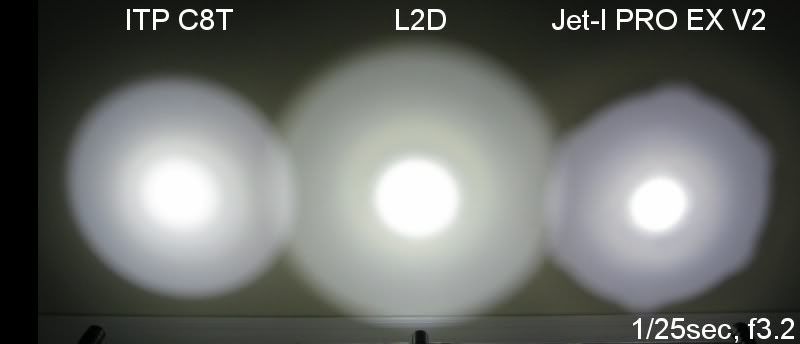
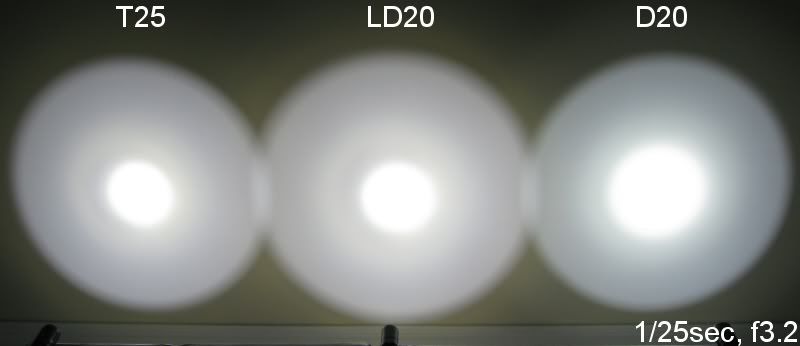
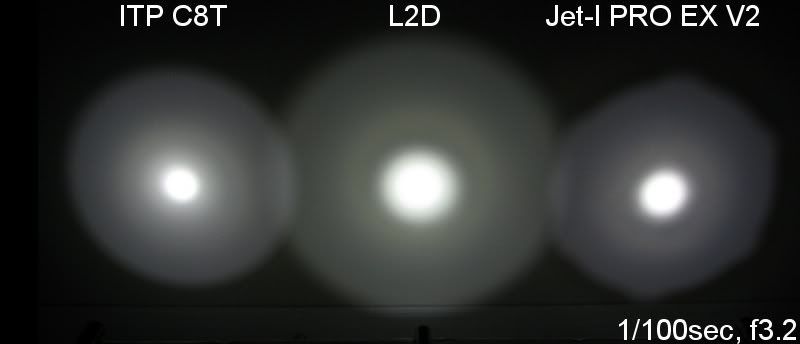
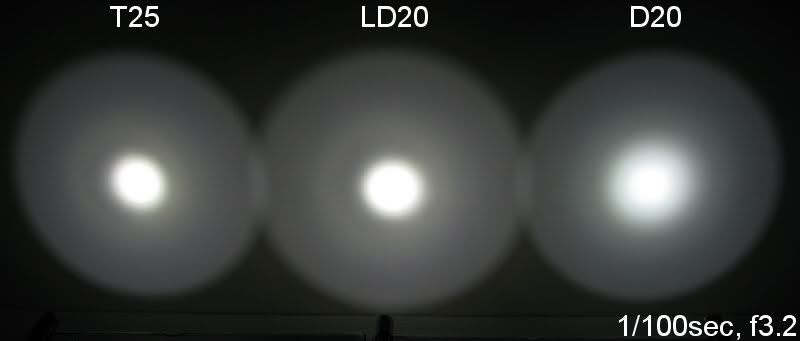
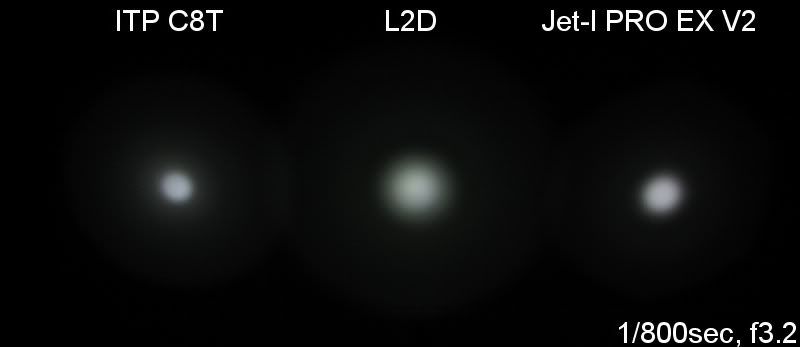
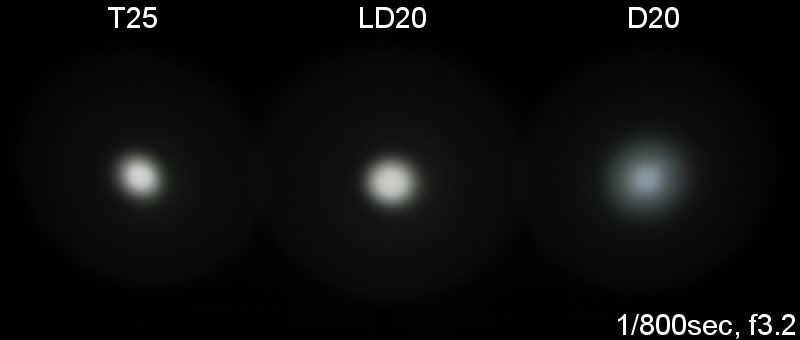
As you can see, the beam profile is again quite different from the typical Cree pattern. Personally I rather like this more diffuse hotspot, but those looking for greater throw will be disappointed.
Testing Method: All my output numbers are relative for my home-made light box setup, a la Quickbeam's flashlightreviews.com method. You can directly compare all my relative output values from different reviews - i.e. an output value of "10" in one graph is the same as "10" in another. All runtimes are done under a cooling fan, except for the extended run Lo/Min modes which are done without cooling.
Throw values are the square-root of lux measurements taken at 1 meter from the lens, using a light meter.
Throw/Output Summary Chart:

On the face of things, it looks like the D20 is definitely brighter on max than the D10 – as you would expect for 2AA light. As previously mentioned, throw is increased, but not by a large margin.
In comparison to the its 2AA brethren, the D20 is toward the high end in terms of max overall output – but my Fenix L2D and LD20 are both brighter. However, the D20 is capable of the lowest output level of any of my 2AA lights. :thumbsup: Throw of the D20 is also the lowest of the 2AA lights.
Output/Runtime Comparison:
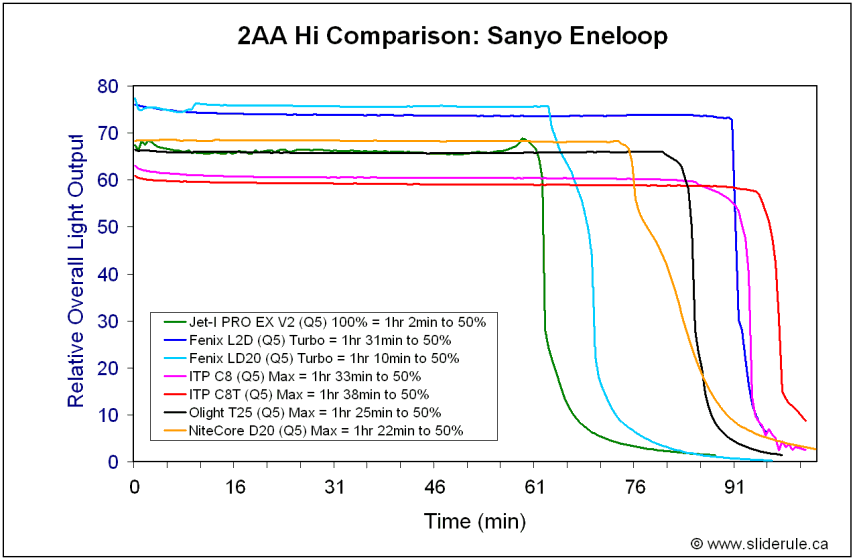
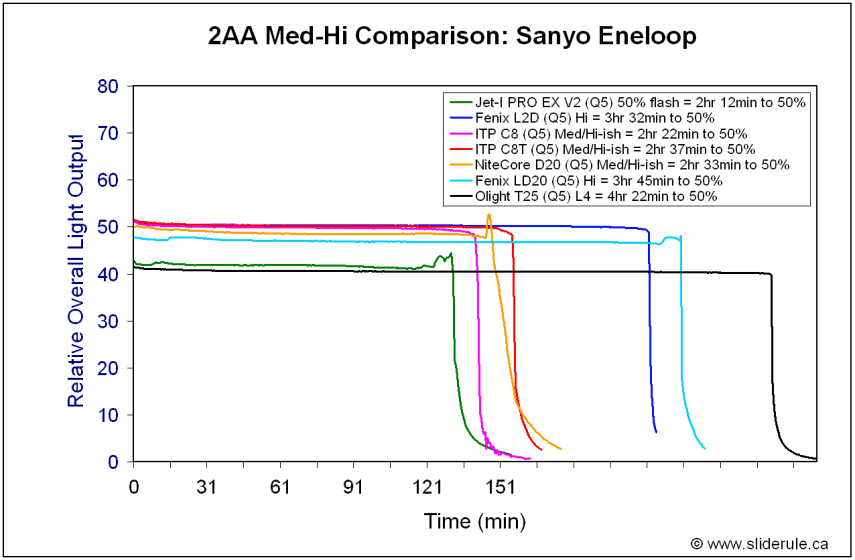
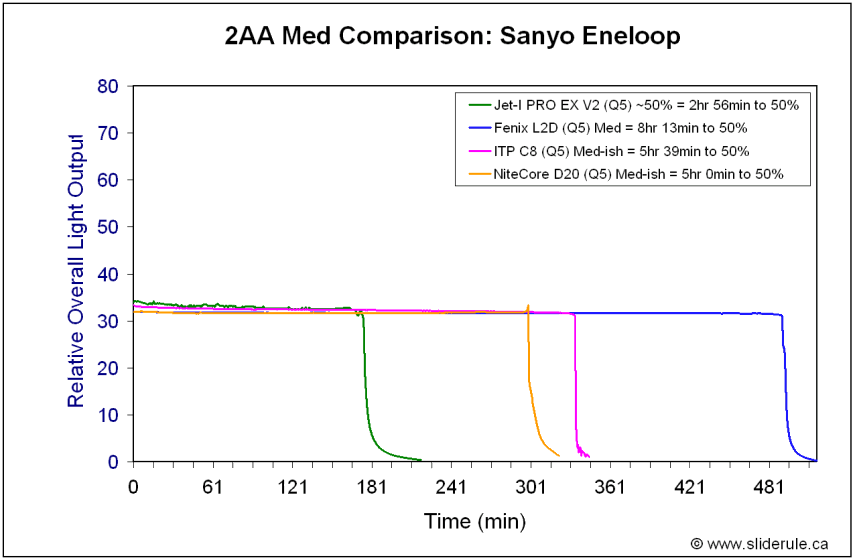
There are no surprises here – the D20 is a consistently good performer at all output levels.
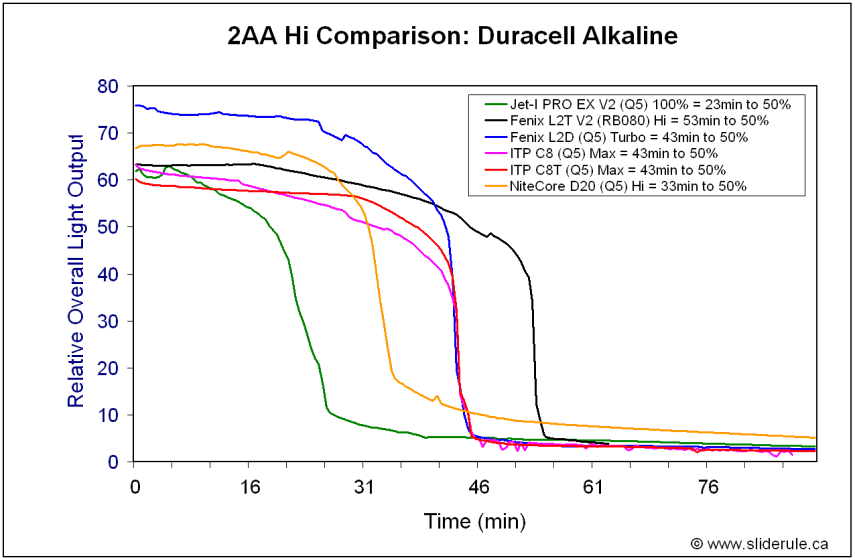
UPDATE: I've done a non-lightbox runtime of the D20 on Low on duracell alkalines and got just over 10 days of continuous runtime. oo:
oo:
Among the continuously-variable lights, the D20 performance is very consistent with the ITP C8 lights, and more efficient than the JetBeam Jet-I PRO EX V2. However the D20 is not as bright on max or as efficient overall as the current-controlled Fenix lights (the latter point is to be expected on a PWM-based light).
Potential Issues
The only significant issue I've observed in testing is the amount of pressure needed on the piston to keep the light ramping smoothly. Even after cleaning and re-lubing, the force required is definitely more than my D10/EX10 lights. To be certain, the original SmartPD lights required some getting used to in this regard, but this one is definitely even more of a challenge.
As for grip, I like the new body design for over- or under-handed use (i.e. thumb on the piston). Although this design includes some built-in finger grips for a cigar hold, I think you would find it difficult to balance and use the light that way (especially for ramping or rapid clicks).
Haven't had a chance to really test out the clip in actual usage, but I wonder how secure those screws will hold it the long-term. Time will tell how well this feature holds up.
UPDATE: Proper level of piston lubrication can also be an issue - which requires the use of tools to remove the clip and retaining ring to re-lube. I'm currently trying Nyogel, since I find the PTFE wears off after awhile.
General Observations & Preliminary Conclusions
The D20 is a welcome addition to the NiteCore SmartPD family of lights. I've always had a soft spot for 2AA lights.
In terms of circuit design, the D20 is definitely an incremental improvement. The automatic reverse ramping and increased output states are positive bonuses. Same goes for some of the new build differences - the pocket clip, stainless steel retaining ring, and piston lock-out features are all useful new additions. I imagine we will start seeing these features in the other members of the SmartPD family as well. :thumbsup:
Overall, I like the sturdy design of the D20 (except for stiffer piston feel). But one of my favourite aspects of the D10/EX10 series was their slim-lined design. Those lights were among the smallest lights of their class, whereas the D20 is one of largest. :shrug: If you are looking for a similarly minimalist 2AA light, you will have to look elsewhere.
The reflector design is interesting – this is one of smoothest Cree beam profiles I've seen. But unlike shallow reflectors (which smooth out rings but produce a wide and dim spillbeam), this deep reflector produces a more even (but narrow) spill output. I will need to play with it more before deciding how I like it – but my experience with the LiteFlux LF5 (which has an even narrower spillbeam) tells me you can get used to just about anything. For a general purpose light, removal of the dark Cree rings is a definite plus – just don't expect a big thrower here.
As always, you need to assess what features matter to you in any given class of light. Now that a number of 2AA lights are on the market, I plan to do a round-up comparison review of this group soon. Stay tuned …
Reviewer's Note: The NiteCore D20 was provided for review by Edgetac (NiteCore).
The NiteCore D20 is the latest offering in the piston-drive "SmartPD" family from Edgetac (NiteCore). Although a lot of the basic design and circuit functioning is similar to the 1AA D10, this new 2AA model features some significant build differences.
The main distinguishing features of all the NiteCore Smart PD lights is their simple continuously-variable interface, and innovative McGizmo "piston drive" design that doesn't use a clicky switch. For a comparison to the 1AA D10, please see my earlier reviews:
NiteCore D10 & EX10 Reviews: RUNTIMES, BEAMSHOTS, COMPARISONS & more!
NiteCore Golden Dragon Plus D10 & EX10 Reviews: BEAMSHOTS, RUNTIMES, etc.

The light comes in a sturdy hard cardboard box with magnetic closing flap. The pocket clip was already attached. Along with the light and clip come a manual, warranty card, good quality wrist strap, extra o-rings, extra clip screws, and a mini-Allen key for the clip screws.
Approximate retail price: $70 USD


Here is how it compares to the competition:

From left to right: Duracell 1AA alkaline, NiteCore D10, NiteCore D20, Fenix L2D, Olight T25, ITP C8 Tactical, JetBeam Jet-I PRO EX V2.
D20 Weight: 109.3g
D20 Dimensions: Length: 154.0mm x Width: 25.0mm (head), 23.2mm tail (without clip)
The obvious build difference on this 2AA version is the heft – the light is surprisingly bulkier than the 1AA model.


One of the most obvious changes is the introduction of the clip at the tailcap, with its stainless steel clip holder and retaining ring. Edgetac includes a mini Allen key, but a 3/32nd hex screwdriver will also fit. The tailcap retaining ring should reinforce the aluminium in this area, and increase long-term durability. :twothumbs
Unlike the 1AA version, the piston cannot be removed from the open end of the body tube (i.e. near the head) – if you want to access the piston, you need to remove the clip and unscrew the piston opening retaining ring (you'll need a pair of tweezers or snap-ring pliers). Not that there is any real reason to do so, unless you want to check the lube status of the piston o-ring.


As you can see in my disassembled pics above, NiteCore is still using a lot of the high-viscosity blue-colour lube on the o-rings. :shrug: Although not causing a problem on this sample, a number of the D10/EX10 lights have issues with "sticking" pistons with this lube. The problem is easily solved after disassembly by a quick wipe off of excess lube, or addition of lower viscosity lube, like PTFE (i.e. Teflon, like from the Radio Shack Precision Oiler)
UPDATE: I find the PTFE lube wears off after a couple of weeks, leading to a "clinking" sound when the bare metal piston meets the aluminum body. I am now trying a little of the more viscous Nyogel 760G, which seems to be working well. Wouldn't normally be a problem to just re-lube periodically, but having to disassemble the clip and retaining ring on the D20 each time means you need to have tools with you.
The purpose of this re-design quickly becomes apparent – the light has a fully functioning tailcap lock-out feature now. :thumbsup: Previously, you could partially lock-out the light by significantly unscrewing the head – making it harder for the piston to engage. But this was not a true lock-out – the piston drive could always be engaged with enough force. Now, the piston can only travel so far up the battery tube, so once you unscrew the head pass a certain point, the light cannot be engaged. Well done.
Fit and finish is excellent on my samples - lettering is very clear and sharp, and anodizing is flawless. Note the knurling on all the NiteCore Smart PD light is more aggressive than pretty much any other Chinese light maker I've seen. Still not quite as severe as Surefire lights, though.


The head/reflector has been redesigned from the D10/EX10/NDI, with a wider and deeper reflector with a new stainless steel bezel ring. Despite this deeper reflector, throw is not increased as much as you might expect (scroll down for a throw/output comparison). My sample came with a Cree Q5 emitter, as you can see.


I've opened the head up to show you the insides - it comes apart fairly easily by unscrewing the bezel retaining ring (i.e. pressing on it firmly with a soft cloth). You can see the spring on the light engine. It all fits together well, so there's no real adjustment you can make. The reflector has a nice groove/lip to help hold the o-ring, so re-assembly is a snap.
Piston Drive & User Interface
Please see my NiteCore D10/EX10 review for a detailed discussion of how the basic Piston Drive mechanism and UI works.
Simply put, the batteries sit inside the piston tube, and switching occurs entirely in the head (i.e. the current path is through the piston sleeve and not the body). The contact ring in the head is spring-mounted, and in combination with the MCU can produce different modes and features depending of degree of force applied to the piston. This innovative design also allows you to utilize the light in a couple of different ways (i.e. as both a "twisty" and "clicky" light).
The UI is actually quite straightforward and easy to use. For a good instruction on how to use it, see 4sevens' D10 video guide here:
http://www.youtube.com/watch?v=irqhuV8Xo_A
So what's new with the circuit? One welcome change is that auto ramping in the reverse direction after using the shortcuts to Min or Max now works. :twothumbs On the 1st generation SmartPD lights, you needed to press and release and press again to get it to start ramping in the reverse direction after using a shortcut (double-click for Min, click-hold for Max).
Another change has been to increase the number of discrete output states from 100 to 256, according to NiteCore. As a result, I would have expected a longer ramping time, but NiteCore has kept the total ramp length down to about 6-7secs, which is just a second longer than the D10/EX10.

If anything, ramping is even more visually-linear now than it was before. But I find I rather miss the slower initial ramp at the lowest outputs (i.e. the D10 spends more time there, proportionally-speaking).
Comparison Beamshots
Both lights are on 100% on Sanyo Eneloop (~2100mAh), about 0.5 meters from a white wall.



As you can see, the beam profile is quite different. Gone on the D20 is the typical dark Cree ring around the hotspot – instead, you can see the D20 hotspot is a lot broader and more diffuse. This relative "defocusing" of the hotspot gives you less throw than you might expect for a bigger reflector. Overall spillbeam width is slightly narrower as well now.
For detailed comparison to its class of 2AA lights, I've rounded up the usual suspects:

From left to right: Duracell 1AA alkaline, NiteCore D10, NiteCore D20, Fenix L2D, Olight T25, ITP C8 Tactical, JetBeam Jet-I PRO EX V2. Not shown is the new Fenix LD20.
All lights are on 100% on 2X Sanyo Eneloop (~2100mAh), about 0.5 meters from a white wall.






As you can see, the beam profile is again quite different from the typical Cree pattern. Personally I rather like this more diffuse hotspot, but those looking for greater throw will be disappointed.
Testing Method: All my output numbers are relative for my home-made light box setup, a la Quickbeam's flashlightreviews.com method. You can directly compare all my relative output values from different reviews - i.e. an output value of "10" in one graph is the same as "10" in another. All runtimes are done under a cooling fan, except for the extended run Lo/Min modes which are done without cooling.
Throw values are the square-root of lux measurements taken at 1 meter from the lens, using a light meter.
Throw/Output Summary Chart:

On the face of things, it looks like the D20 is definitely brighter on max than the D10 – as you would expect for 2AA light. As previously mentioned, throw is increased, but not by a large margin.
In comparison to the its 2AA brethren, the D20 is toward the high end in terms of max overall output – but my Fenix L2D and LD20 are both brighter. However, the D20 is capable of the lowest output level of any of my 2AA lights. :thumbsup: Throw of the D20 is also the lowest of the 2AA lights.
Output/Runtime Comparison:



There are no surprises here – the D20 is a consistently good performer at all output levels.

UPDATE: I've done a non-lightbox runtime of the D20 on Low on duracell alkalines and got just over 10 days of continuous runtime.
Among the continuously-variable lights, the D20 performance is very consistent with the ITP C8 lights, and more efficient than the JetBeam Jet-I PRO EX V2. However the D20 is not as bright on max or as efficient overall as the current-controlled Fenix lights (the latter point is to be expected on a PWM-based light).
Potential Issues
The only significant issue I've observed in testing is the amount of pressure needed on the piston to keep the light ramping smoothly. Even after cleaning and re-lubing, the force required is definitely more than my D10/EX10 lights. To be certain, the original SmartPD lights required some getting used to in this regard, but this one is definitely even more of a challenge.
As for grip, I like the new body design for over- or under-handed use (i.e. thumb on the piston). Although this design includes some built-in finger grips for a cigar hold, I think you would find it difficult to balance and use the light that way (especially for ramping or rapid clicks).
Haven't had a chance to really test out the clip in actual usage, but I wonder how secure those screws will hold it the long-term. Time will tell how well this feature holds up.
UPDATE: Proper level of piston lubrication can also be an issue - which requires the use of tools to remove the clip and retaining ring to re-lube. I'm currently trying Nyogel, since I find the PTFE wears off after awhile.
General Observations & Preliminary Conclusions
The D20 is a welcome addition to the NiteCore SmartPD family of lights. I've always had a soft spot for 2AA lights.
In terms of circuit design, the D20 is definitely an incremental improvement. The automatic reverse ramping and increased output states are positive bonuses. Same goes for some of the new build differences - the pocket clip, stainless steel retaining ring, and piston lock-out features are all useful new additions. I imagine we will start seeing these features in the other members of the SmartPD family as well. :thumbsup:
Overall, I like the sturdy design of the D20 (except for stiffer piston feel). But one of my favourite aspects of the D10/EX10 series was their slim-lined design. Those lights were among the smallest lights of their class, whereas the D20 is one of largest. :shrug: If you are looking for a similarly minimalist 2AA light, you will have to look elsewhere.
The reflector design is interesting – this is one of smoothest Cree beam profiles I've seen. But unlike shallow reflectors (which smooth out rings but produce a wide and dim spillbeam), this deep reflector produces a more even (but narrow) spill output. I will need to play with it more before deciding how I like it – but my experience with the LiteFlux LF5 (which has an even narrower spillbeam) tells me you can get used to just about anything. For a general purpose light, removal of the dark Cree rings is a definite plus – just don't expect a big thrower here.
As always, you need to assess what features matter to you in any given class of light. Now that a number of 2AA lights are on the market, I plan to do a round-up comparison review of this group soon. Stay tuned …
Last edited:


 ).
). 
